Causal or Experimental Research Designs
With an experimental research design, the researcher lays out how he or she will manipulate one of more independent variables and measure their effect on the dependent variable. Some research designs involve no manipulation of independent variables. These non-experimental designs are called ex post facto, or after the effect, studies.
An experimental design must deal with four issues:
- The people who participate in the experiment.
- The independent variable or variables, which are also called the treatment variables. These are the variables the researchers manipulate during the experiment.
- The dependent variable, or the effect that the researchers measure.
- The plan for controlling extraneous variables.
Types of Experimental Research Designs
Experimental research designs can be classified into the following typology:
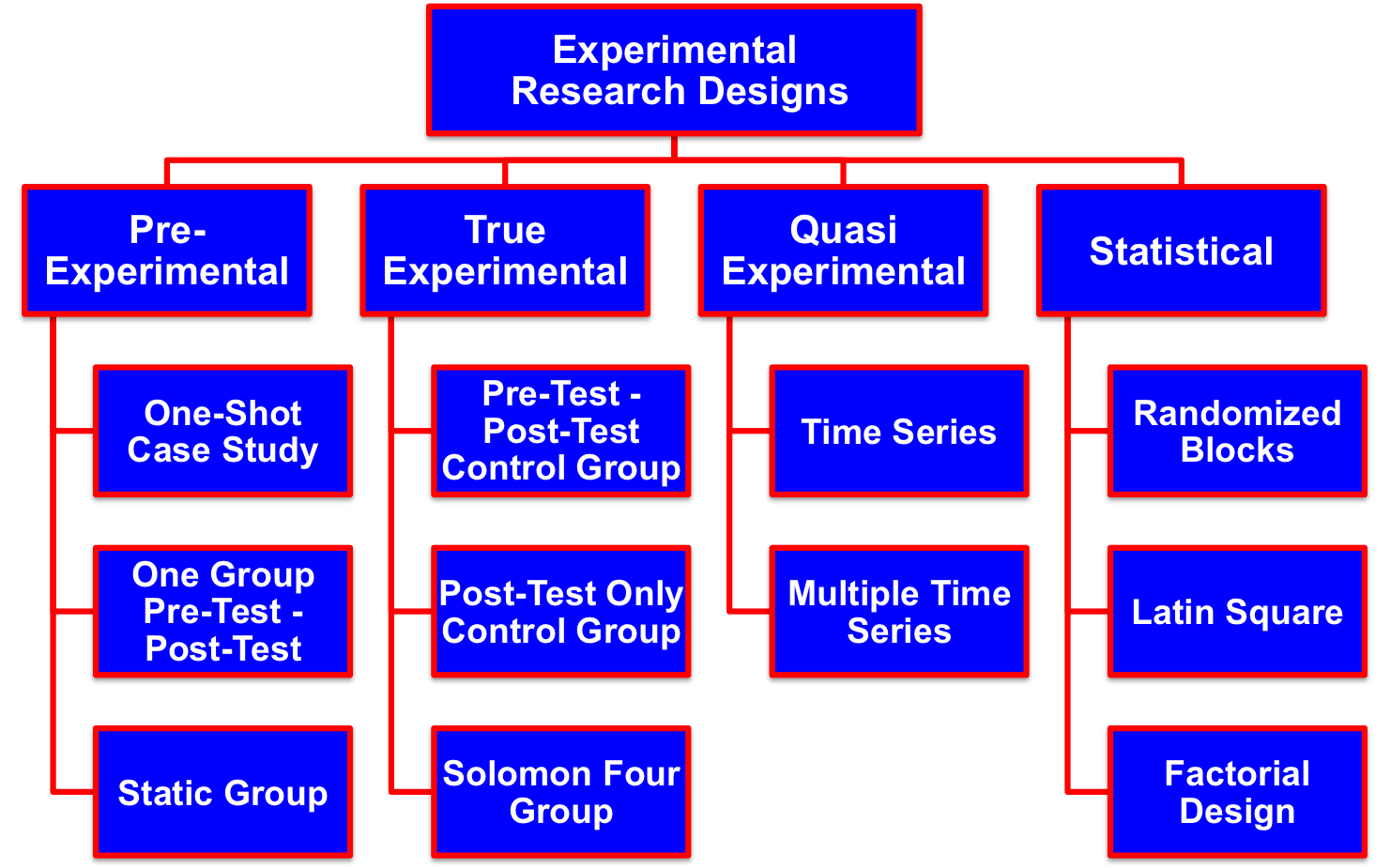
Figure 1
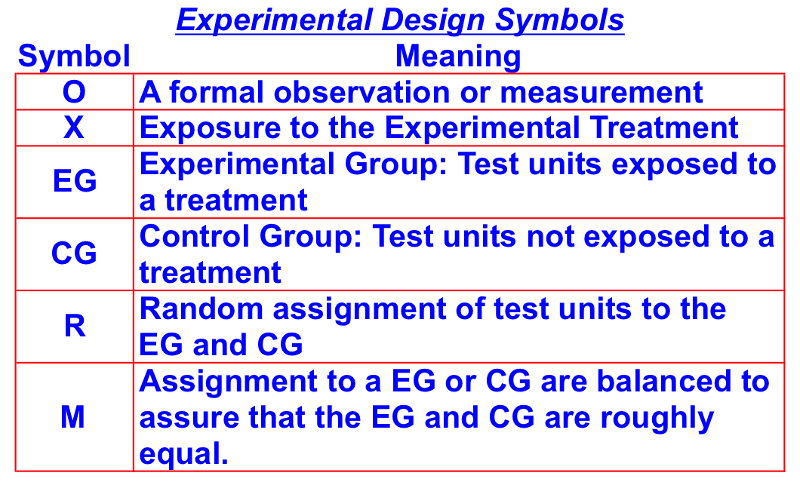
Figure 2
Pre-Experimental Designs
Pre-Experimental Designs are the simplest form of experimental research designs. Pre-experimental designs have little or no control over extraneous variables. And, these designs do not randomly assign subjects to different treatments. As a consequence, the results of a test using a pre-experimental design are difficult to interpret. These designs are often used in testing television commercials because they are simple and relatively inexpensive.
There are three types of pre-experimental designs: One-Shot Case Studies, One Group Pre-Test - Post-Test, and Static Group tests
A. One-Shot Case Studies: With a one-shot case study, test units—people, test markets, etc.—are exposed to a treatment. The standard notion for a treatment is the symbol "X." A single measurement of the dependent variable is taken (O1). There is no random assignment of test subjects as there is only one treatment, and there is no control. Here is the standard notation for a One-Shot Case Study:

Figure 3
This research design has two significant flaws: 1) there is no pre-test and 2) there is no control group. A control group would, in this case, be a group that did not receive the treatment. Without these restraints, this research design cannot establish internal or external validity.
Despite these limitations, market researchers often use this design for testing new-to-the-market products.
B. One Group Pre-Test - Post-Test: With this research design the test unit is measured twice, one before the test and once after the test. There is still no control group; which is to say, a group not receiving the treatment. Here is the standard notation for a one-group pre-test - post-test study:

Figure 4
Marketing researchers often use this design to test changes in the marketing plan for established products. Compared to One-Shot Case Studies, this design has the advantage of taking two measurements: one before and the other after exposure to the treatment. This allows the researcher to estimate the treatment effect by subtracting the pre-test measure from the post-test measure. But, given the lack of a control, the validity of the conclusions are questionable. Extraneous variables like history can affect the results because the observed changes in the dependent variable might be due to factors outside the research design. And, maturation can also be a problem as the observed changes to the dependent variable might be due to changes in the test subjects that are not related to the treatment.
C. Static Group Design: With the Static Group design there is a Control Group (CG) in addition to the Experimental Group (EG). The experimental group is exposed to the treatment while the control group is not. Test units, however, are not randomly assigned to the control or experimental groups. Here is the standard notation for a Static Group study:
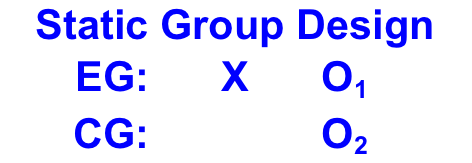
Figure 5
Measurements for both groups are made after the treatment is administered to the experimental group. The treatment effect is measured as O1 - O2.
Weaknesses of this research design stem from the fact that test units are not randomly assigned to the experimental or control groups and there are no pre-test measurements taken.
True Experimental Designs
True Experimental Designs are where the market researchers assign test units to treatments at random. There are three basic types of True Experimental Designs: Post-Test Only Control Group Design, Pre-Test Post-Test Control Group Design, and Solomon Four Group Design.
A. Post-Test Only Control Group Design:
With this research design, test units are randomly assigned to the experimental and control groups. The experimental group is exposed to the treatment and then both the experimental and control groups are measured. But, there is only one measurement is taken.
Here is the standard notation for a Post-Test Only study:
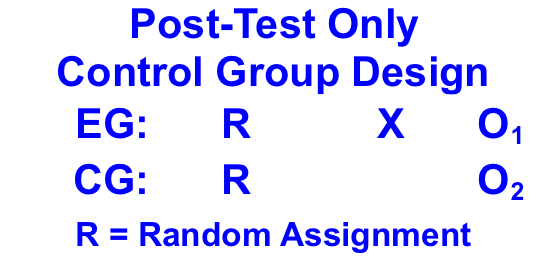
Figure 6
The effect of the treatment is calculated as O1 - O2.
The advantage of this research design is that the random assignment of the test units should produce roughly equal control and experimental groups before the treatment is administered. And, the mortality for the control and experimental groups should be similar.
B. Pre-Test - Post-Test Control Group Design:
With this research design, test units are randomly assigned to experimental and control groups. A pre-test measure is taken from both groups.
Here is the standard notation for a Pre-Test - Post-Test Control Group study:
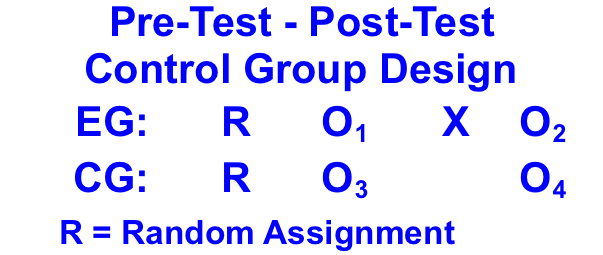
Figure 7
Selection bias is controlled by the randomized assignments of test units. Mortality can be a problem if it is not relatively equal between the experimental and control groups. History can also be an issue if these factors effect the experimental and control groups unequally.
The treatment effect or TE is measured by (O2 O1) - (O4 O3).
C. Solomon Four Group Design:
The Solomon Four Group Design is a research design that assesses the impact of pretesting on subsequent measures.[i] It is used when the researcher suspects that earlier tests influence the results of later tests. With this research design, test units are randomly allocated to two experimental groups and two control groups. One of the experimental groups and one of the control groups is measured. Both experimental groups are then exposed to a treatment. Afterwards, both experimental and control groups are measured. A total of six measurements are taken. The design aims to account for pre-testing bias and pre-test manipulation interaction bias.
Here is the standard notation for a Solomon Four Group study:
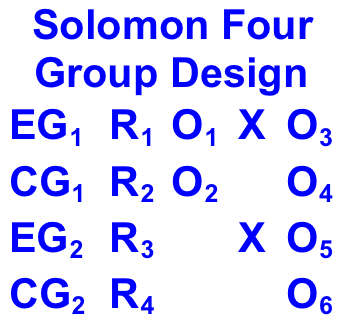
Figure 8
Quasi-Experimental Designs
Quasi-Experimental Designs are used when the researcher creates an artificial environment to control for extraneous variables. With quasi-experimental designs, the research lacks control over when the treatment is administered or assigns test units to the experimental and control groups in a non-random fashion. There are two basic types of quasi-experimental designs: Time Series and Multiple Time Series.
A. Time Series: There is no randomization of the test units to the treatments. The timing of the treatment presentation as well as which test unites are exposed to the treatment may not be within the researcher's control. Consumer Attitude & Usage panels are an example of quasi-experimental designs using Time Series.
Here is the standard notation for a Time Series study:

Figure 9
The advantages of Time Series are that it is easier to interpret the results than a One Group Pre-Test - Post-Test design because of the many measures it takes. The multiple measures help determine underlying trends. But, the Time Series design has two weaknesses. First, researchers cannot control history. Second, given the repeated measures there is a testing effect on the subjects. Subjects may become more aware of their shopping habits, which could influence the results of the study.
B. Multiple Time Series: With the Multiple Time Series, the researchers add a control group to the research design. The addition of a control group enhances the researchers' ability to discern the treatment effect.
Here is the standard notation for a Multiple Time Series study:

Figure 10
Statistical Designs
Statistical Designs are a collection of basic experimental designs that offer researchers the ability to statistically control and analyze external variables. Statistical control uses various sophisticated statistical techniques to exclude the influence of extraneous variables from an analysis.
The most commonly used Statistical Research Designs are the Randomized Block Design, the Latin Square Design, and the Factorial Design. These designs offer the following advantages: 1) The effects of multiple independent variables on the dependent variable can be measured, 2) Specific extraneous variables can be statistically controlled, and each test unit can be measured more than once with these economically efficient designs. These designs are beyond the scope of an introductory Marketing Research class. We will not, therefore, cover them in any detail.
[i] Paul J. Lavraka. (2008). Encyclopedia of Survey Research Methods. http://srmo.sagepub.com/view/encyclopedia-of-survey-research-methods/n540.xml
toc | return to top | previous page | next page

